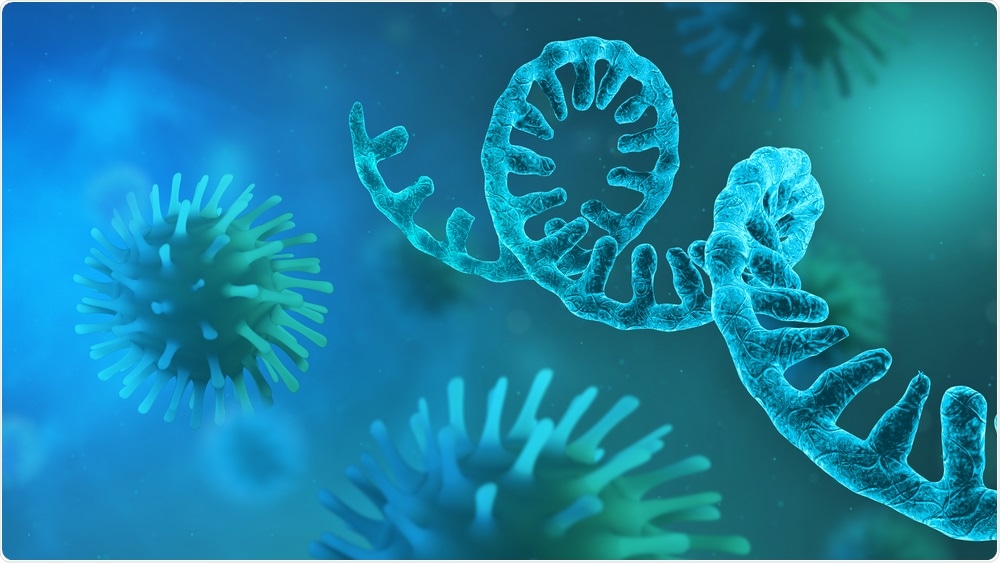The coronavirus disease 2019 (COVID-19) is caused by the severe acute respiratory syndrome coronavirus 2 (SARS-CoV-2), which is a highly virulent virus. Evidence suggests that disruption of host epigenetic pathways by viruses occurs by the mechanism of mimicry of host cell proteins, particularly histones. Histones bind to deoxyribonucleic acid (DNA) in the nucleus and subsequently facilitate it to condense to form chromatin.
Histones are subjected to a variety of post-translational modifications (PTMs) that play a role in the regulation of gene expression in a cell. Histone mimicry is a mechanism through which viruses dysregulate host gene expression, thus disrupting the host response to infection.
A recent study published on the preprint server bioRxiv* investigates histone mimicry as a mechanism employed by SARS-CoV-2 for disrupting epigenetic regulation to evade host cell responses to infection.
 Study: SARS-CoV-2 ORF8 encoded protein contains a histone mimic, disrupts chromatin regulation, and enhances replication. Image Credit: CROCOTHERY / Shutterstock.com
Study: SARS-CoV-2 ORF8 encoded protein contains a histone mimic, disrupts chromatin regulation, and enhances replication. Image Credit: CROCOTHERY / Shutterstock.com
Matching regions identified between Orf8 and amino-terminal tail of histone H3
The scientists in this study performed a bioinformatics comparison of SARS-CoV-2 viral proteins with human histone proteins to determine whether histone mimicry is employed by SARS-CoV-2 during infection. They identified a match between the regions in the protein encoded by ORF8 (Orf8) and in the amino-terminal tail of the histone H3. Notably, Orf8 was found to align with a long stretch of six identical and sequential amino acids.
The region of the histone that aligns with Orf8 contains the ‘ARKS’ sequence, which is a critical regulatory region in histone H3 and is present at two different sites on the histone tail. ARKS sites are subjected to post-translational modifications like methylation and acetylation at H3 Lysine 9 (H3K9me3 and H3K9ac) and H3 Lysine 27 (H3K27me3 and H3K27ac).
Further, evidence from patient samples shows that the ORF8 transcript is highly expressed within 24 hrs of SARS-CoV-2 infection as compared to histone H3 transcripts. Orf8 may function as a histone mimic and interrupt the regulation at ARKS sites present on histone H3, thereby promoting SARS-CoV-2 pathogenicity.
Orf8 may function as a histone mimic
In vitro studies were performed to assess the intracellular localization of Orf8. It was observed that Orf8 localized in the cytoplasm at the periphery of the nucleus and colocalized with LaminB1 and LaminA/C, which are nuclear proteins. Cell fractionation studies further confirmed the presence of Orf8 in both the cytoplasm and nucleus.
The scientists also examined Orf8 binding to chromatin by employing increasing salt concentrations. Subsequently, Orf8, lamin, and histones dissociated from chromatin at similar salt concentrations.
Deletion of the ARKSAP motif from the histone mimic site influences the strength of binding of Orf8, the absence of which enables dissociation at lower salt concentrations. Chromatin immunoprecipitation with high-throughput DNA sequencing (ChIP-seq) was performed and indicated that Orf8 associates with chromatin and is found in regions of the genome that contain H3K27me3 and H3K9me2.
Immunoprecipitation experiments were conducted to identify the specific proteins that associate with Orf8. Orf8 was found to co-immunoprecipitate with LaminB1, histone H3 HP1a, and with histone-modifying enzyme acetyltransferase KAT2A/GCN5, which acts on H3K9 present at the ARKS motif in histone H3. Further studies utilizing mass spectrometry found that Orf8 also binds with mortality factor 4-like protein (MORF4L), which is a histone acetyltransferase (HAT) complex protein, zinc finger proteins, and to the transcription factor SP2.
Liquid chromatography followed by parallel reaction monitoring mass spectrometry (LC-PRM-MS) was also performed. These experiments revealed that a lysine residue present on the ARKS histone mimic site is acetylated in Orf8, which suggests the possibility that a part of Orf8 may exist as a monomer in cells. Additionally, apart from associating with histone-modifying enzymes like the acetyltransferase KAT2A, Orf8 also undergoes similar modification to Histone H3 by these enzymes.
The findings from these studies show that Orf8 localizes at the nuclear lamina and associates with chromatin and histone-modifying enzymes like KAT2A, thereby supporting that Orf8 may function as a histone mimic.
Orf8 disrupts post-translational modifications on histone H3
The scientists further investigated whether Orf8 disrupts chromatin regulation. They performed in vitro studies with human embryonic kidney (HEK) cells transfected with Orf8 followed by unbiased mass spectrometry to detect the post-translational modifications at the histones.
These studies showed that in cells expressing the Orf8 protein, histone modifications that promoted gene expression was inhibited, while those that promoted chromatin compaction that resulted in transcriptional repression were increased. Notably, the histone modifications at the ARKS motif were inhibited.
Interestingly, peptides containing post-translational modifications H3K9ac and H3K14ac which promote gene expression were decreased. Further, an increase in peptides having H3K9 methyl modifications (H3K9me2 and H3K9me3) and H3K27 methylation (H3K27me3 and H3.3K27me3) were observed. These findings further support that Orf8 is a histone mimic and can dysregulate PTMs at important sites on the histone.
Immunofluorescence imaging of HEK cells expressing Orf8 indicated increased levels of H3K9me3 and H3K27me3 and decreased levels of H3K9ac. Experiments with deletion constructs of Orf8 that do not contain the ARKSAP histone mimic site (Orf8DARKSAP) revealed that it had no effect on H3K9me3 or H3K27me3. Furthermore, this deletion had a non-significant effect on H3K9ac, thereby suggesting that this site is important for dysregulation of PTMs by Orf8.
The acquired mutation S84L (Orf8S84L) has been detected in Orf8 from SARS-CoV-2 strains. Orf8S84L was also found to perform similar to the unmutated version of Orf8, increase H3K9me3 or H3K27me3, and decrease H3K9ac. These observations suggest that this mutation does not affect the function of Orf8 to disrupt PTM.
The gene expression changes caused by Orf8 and Orf8DARKSAP were also investigated and differences were observed in the expression of gene groups in the case of Orf8 and Orf8DARKSAP . Further, it was found that Orf8 decreased the expression of genes that were related to DNA regulation and cell signaling pathways.
Orf8 disrupts histone modifications during SARS-CoV-2 infection
Several experiments were performed with wild-type SARS-CoV-2 and recombinant mutant SARS-CoV-2 with deleted Orf8 (SARS-CoV-2 DORF8). A549ACE cells overexpressing angiotensin-converting enzyme (ACE) receptors were infected with SARS-CoV-2 or SARS-CoV-2 DORF8 .
In cells infected with SARS-CoV-2, increased H3K9me3 and H3K27me3 and a reduction in H3K9ac was observed. This effect was not observed in cells infected with SARS-CoV-2 DORF8, thus suggesting the role of Orf8 in the dysregulated histone PTM.
Additionally, chromatin compaction resulting in decreased chromatin accessibility observed in the case of wild type SARS-CoV-2 was not present in the case of SARS-CoV-2 DORF8. This observation confirms the role of Orf8 in disrupting histone modifications during SARS-CoV-2 infection.
The findings from this study were further corroborated by assessing post-mortem lung samples from three COVID-19 patients. The cells were stained to identify the presence of H3K9me3 and SARS-CoV-2 nucleocapsid protein, which will identify infected cells.
Infected cells exhibited increased staining for H3K9me3 when compared to uninfected cells and control tissues. Although the sample size in this analysis is small, the findings suggest dysregulated histone PTMs in COVID-19 patients with severe disease.
Further experiments with induced human pluripotent stem cell-derived lung alveolar type 2 (iAT2) pulmonary cells confirmed that Orf8 increased viral replication in these cells.
Orf8 causes repression of transcriptional changes in host occurring in response to SARS-CoV-2 infections
The role of Orf8 in the transcriptional changes due to SARS-CoV-2 infection was investigated. Adenocarcinomic human alveolar basal epithelial cells expressing high levels of ACE receptor (A549ACE ) were infected with SARS-CoV-2 or SARS-CoV-2 DORF8 and RNA-seq was performed post-infection to detect the transcriptional changes.
In wildtype SARS-CoV-2 infected cells, the levels of Orf8 transcript were found to be higher than the transcripts for human proteins. The SARS-CoV-2DORF8 infected cells showed high levels of differentially expressed genes compared to wild-type infected cells.
This indicates that Orf8 represses transcriptional changes occurring in response to infection, particularly at the early stage of infection. Further, in SARS-CoV-2DORF8 infected cells, increased transcription of genes such as interferon response genes and cytokine-encoding genes that play a role in the host cell response was observed.
Conclusion
Previous reports in 2020 state that patients who were infected with SARS-CoV-2 with a deletion in ORF8 exhibited better immune responses and health outcomes. The findings from this study indicate that Orf8 disrupts epigenetic changes through histone mimicry, thus suggesting a molecular mechanism for the role of Orf8 in SARS-CoV-2 infections.
The present study demonstrates histone mimicry as a mechanism through which SARS-CoV-2 disrupts epigenetic regulation resulting in suppression of host response to infection. Further investigations are required to confirm whether drugs targeting epigenetic pathways that influence SARS-CoV-2 infection may prove beneficial in COVID-19 patients.
*Important notice
bioRxiv publishes preliminary scientific reports that are not peer-reviewed and, therefore, should not be regarded as conclusive, guide clinical practice/health-related behavior, or treated as established information.
- Kee, J., Thudium, S., Renner, D., et al. (2021). SARS-CoV-2 ORF8 encoded protein contains a histone mimic, disrupts chromatin regulation, and enhances replication. bioRxiv. doi:10.1101/2021.11.10.468057. https://www.biorxiv.org/content/10.1101/2021.11.10.468057v1.
Posted in: Molecular & Structural Biology | Medical Science News | Medical Research News | Disease/Infection News
Tags: Acetylation, Angiotensin, Bioinformatics, Cell, Cell Signaling, CHIP, Chromatin, Chromatography, Coronavirus, Coronavirus Disease COVID-19, Cytokine, Cytoplasm, DNA, DNA Sequencing, Drugs, Enzyme, Gene, Gene Expression, Genes, Genome, Histones, Imaging, Immunoprecipitation, in vitro, Interferon, Intracellular, Kidney, Liquid Chromatography, Lysine, Mass Spectrometry, Mortality, Mutation, Peptides, Protein, Receptor, Respiratory, RNA, SARS, SARS-CoV-2, Severe Acute Respiratory, Severe Acute Respiratory Syndrome, Spectrometry, Syndrome, Transcription, Virus, Zinc

Written by
Dr. Maheswari Rajasekaran
Maheswari started her science career with an undergraduate degree in Pharmacy and later went on to complete a master’s degree in Biotechnology in India. She then pursued a Ph.D. at the University of Arkansas for Medical Sciences in the USA.
Source: Read Full Article
